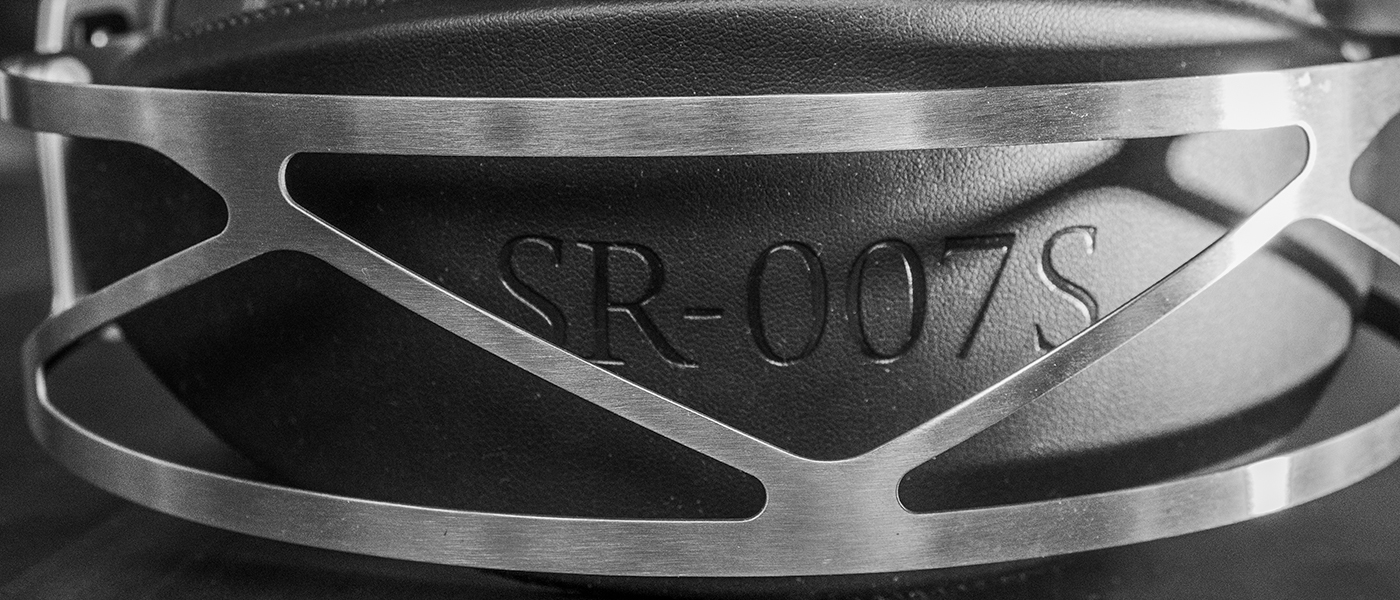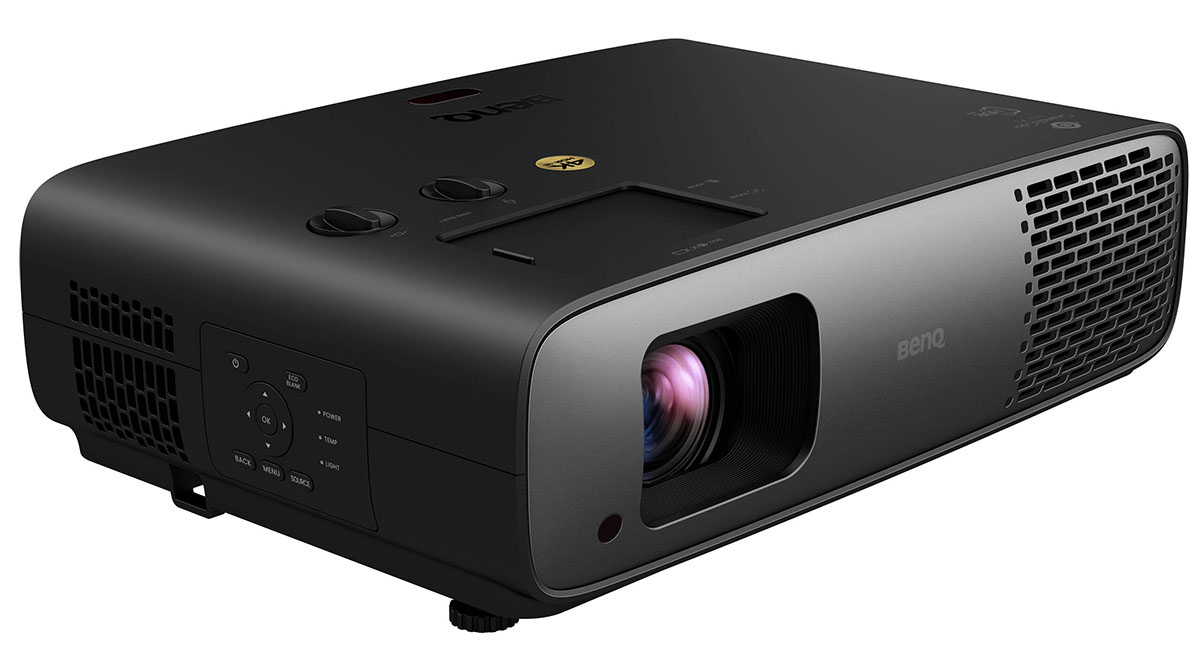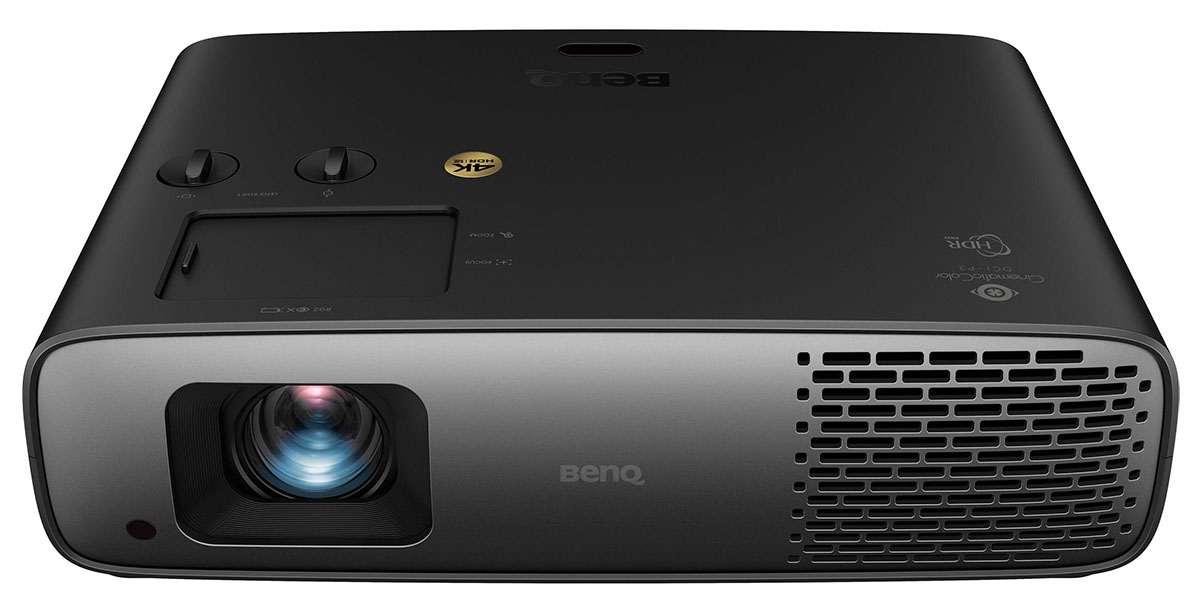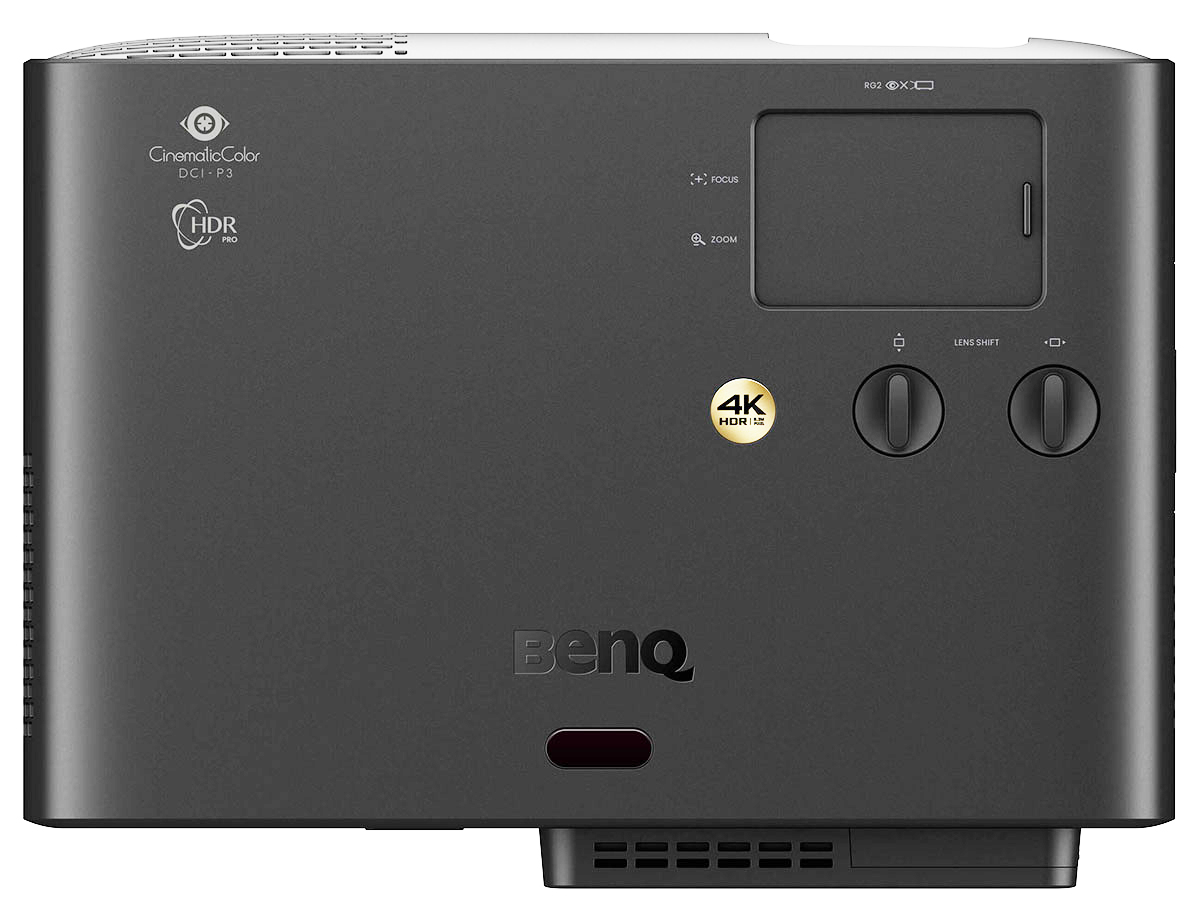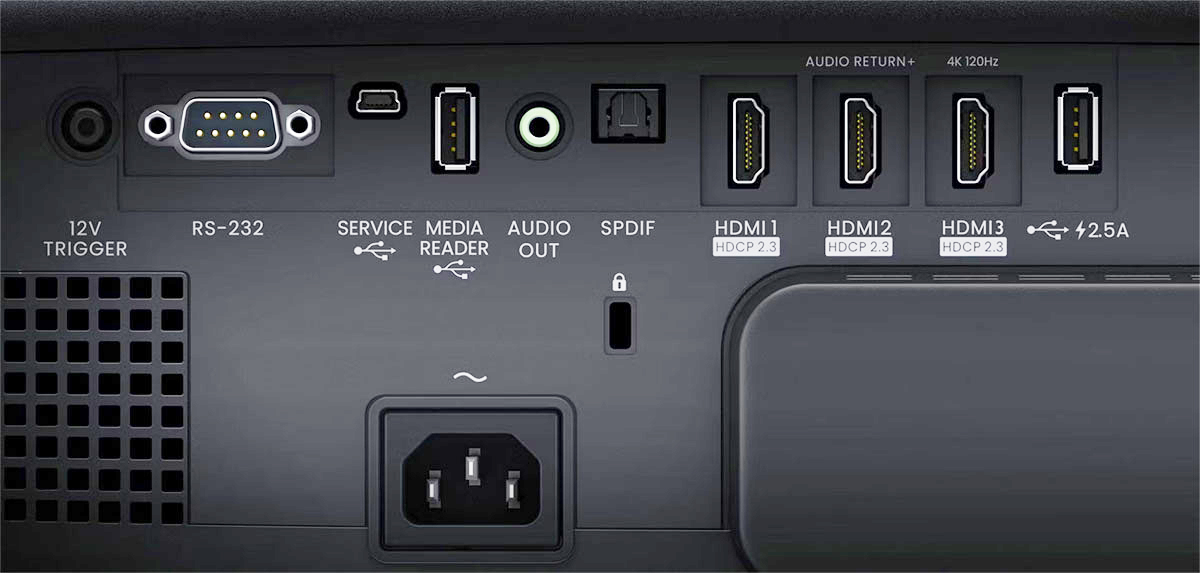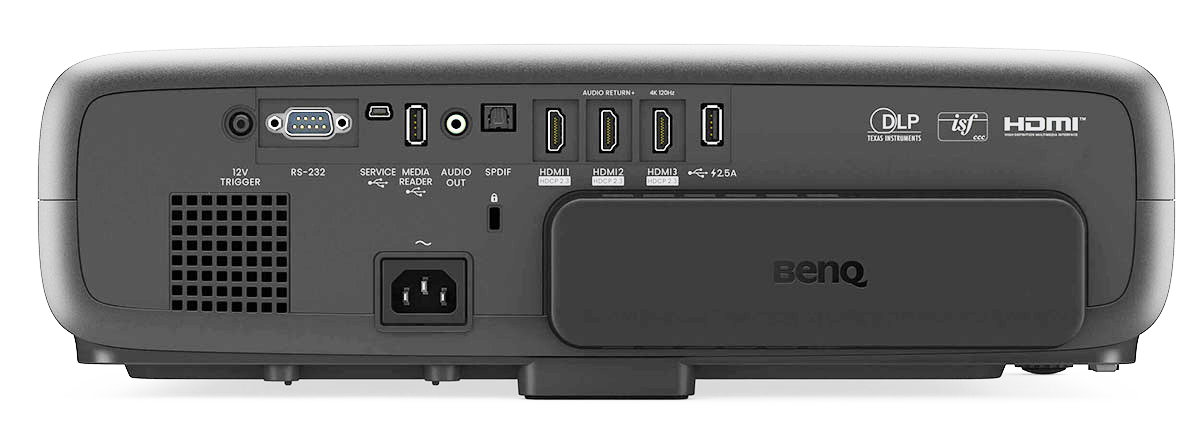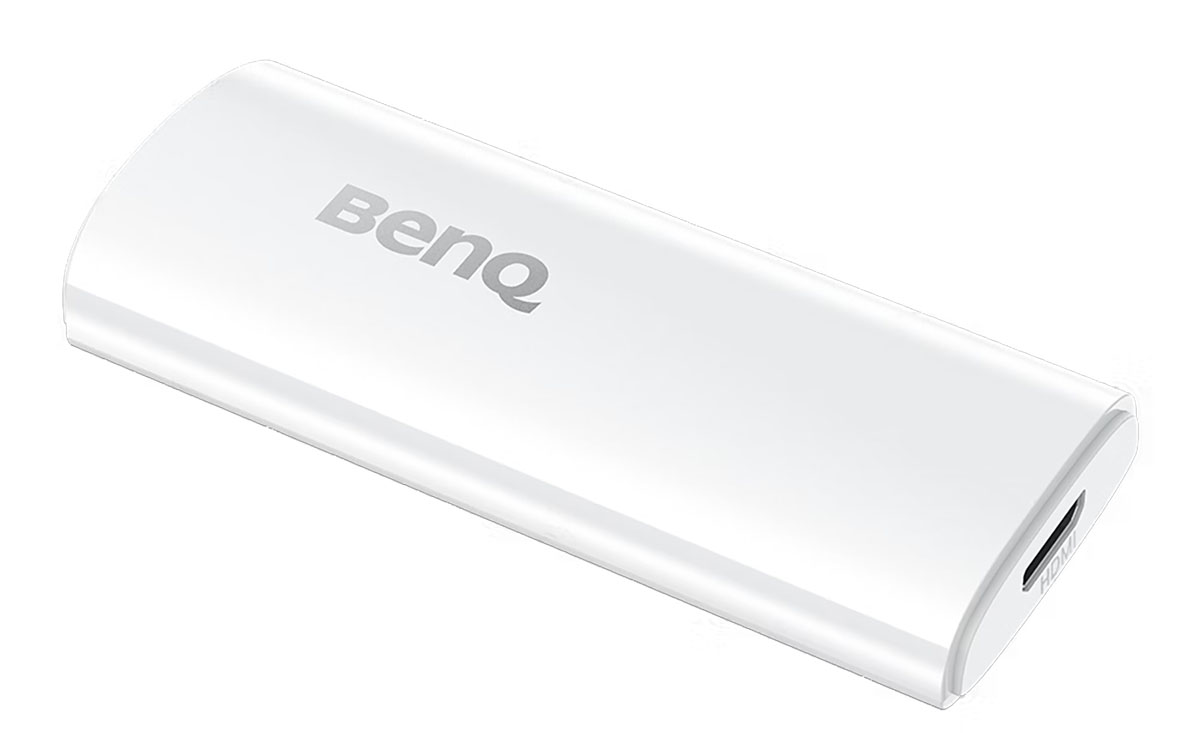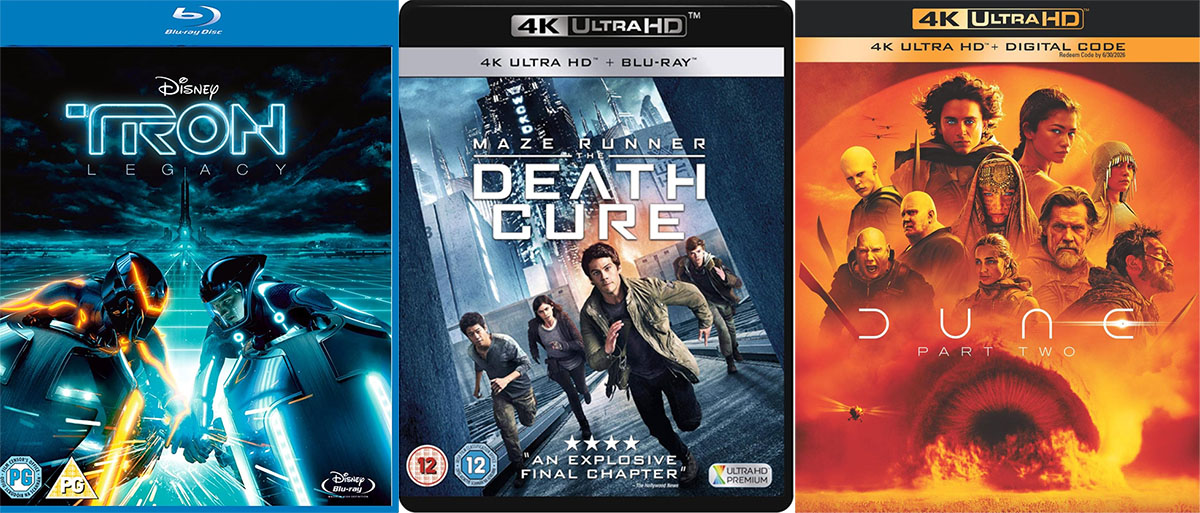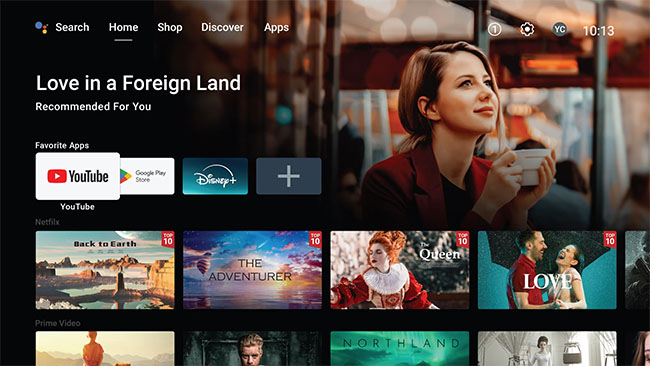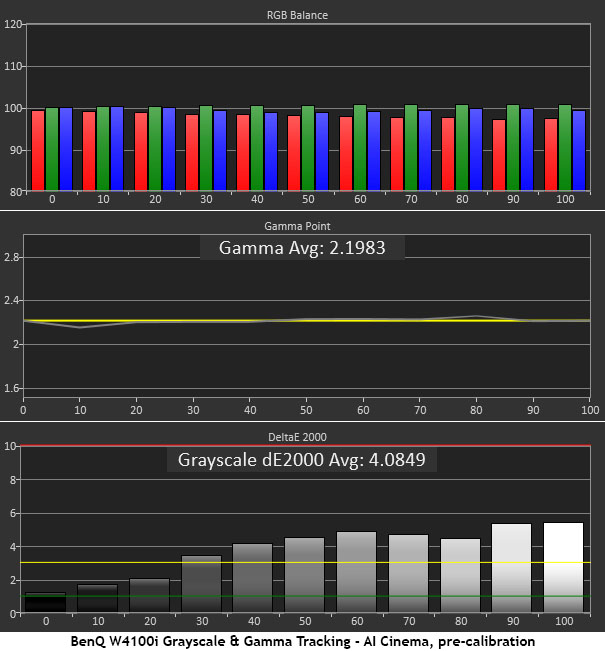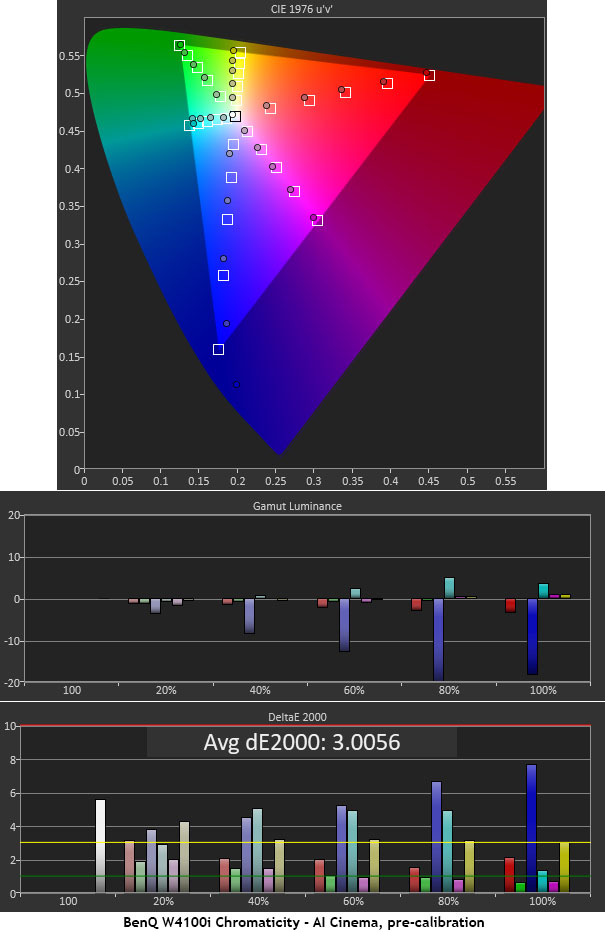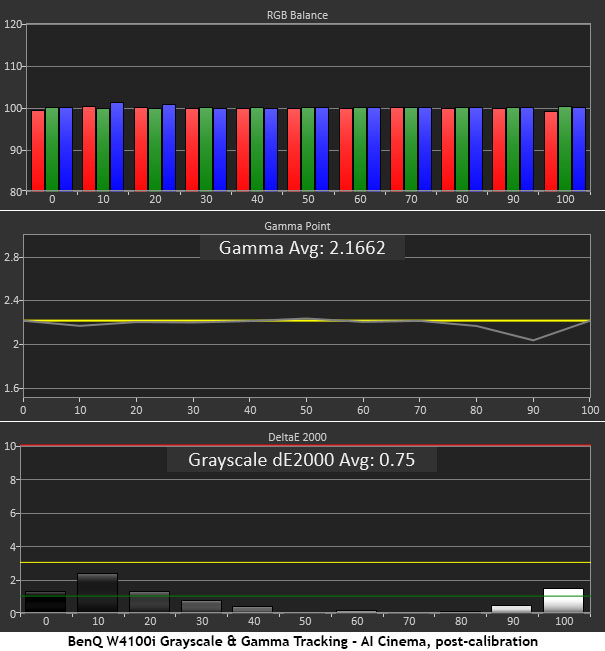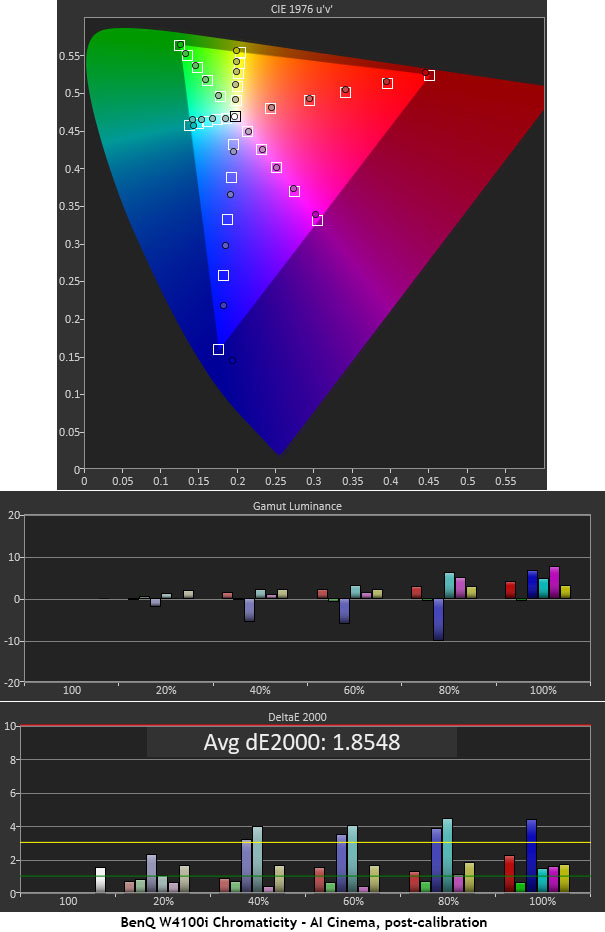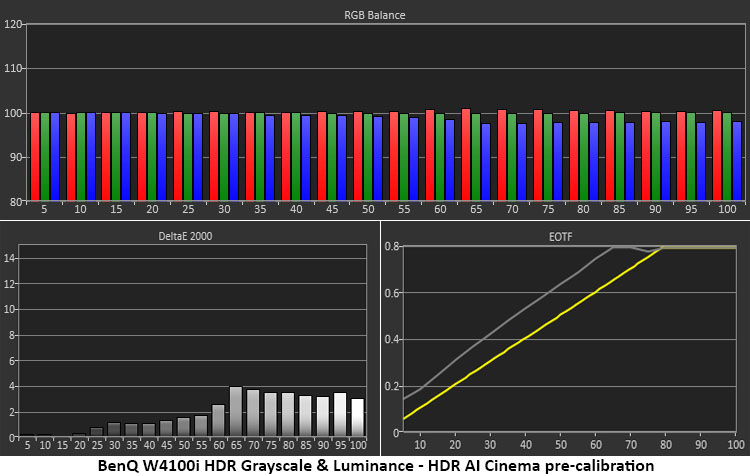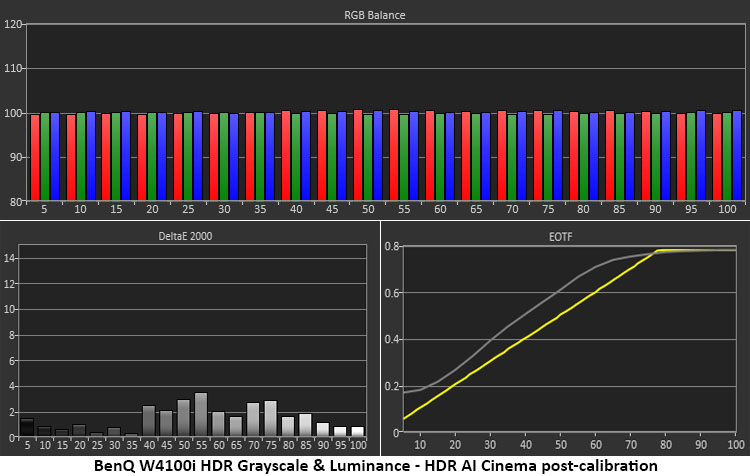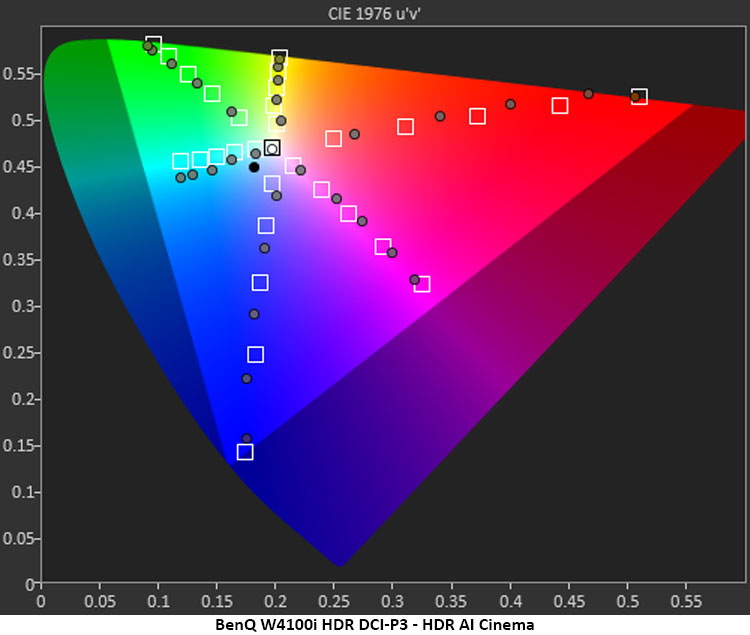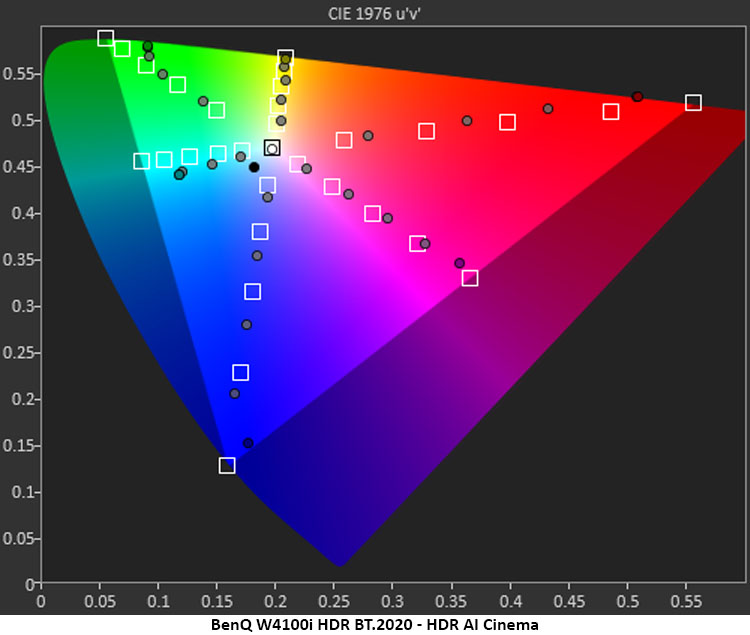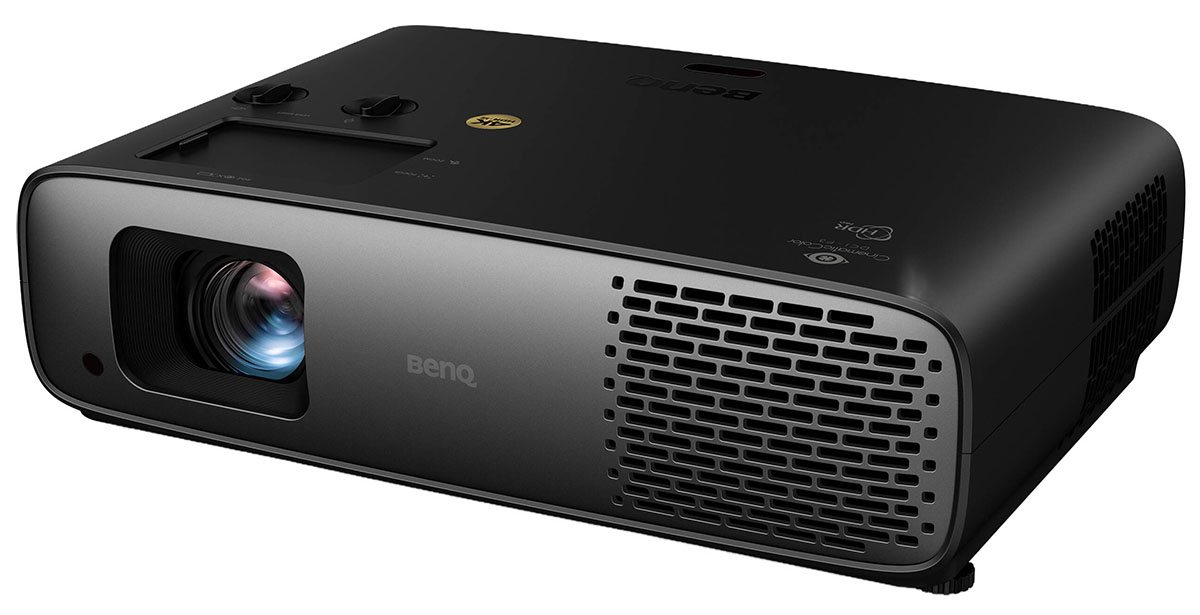It delivers 3,200 lumens and 100% coverage of DCI-P3 along with Google TV and integrated audio.
The BenQ W4100i 4K Home Cinema Projector is a semi-compact 4LED display with Ultra HD resolution, 100% coverage of the DCI-P3 color gamut, 3,200 lumens, Android TV, and integrated audio. For a hair under $3,000, it brings a bright, sharp, and colorful picture to medium and large home theaters or media rooms. Lens shift and zoom make for flexible and easy installation. It also includes multiple control options for home automation systems, and it works with Google Assistant and Chromecast.
BenQ W4100i 4K Home Theater Projector
- 4K 4LED DLP projector
- 3,200 lumens and 100% coverage of DCI-P3 color
- AI picture modes and 3D support
- HDR10, HDR10+, and HLG support with dynamic tone mapping
- Auto Low Latency Mode for gaming
- Mechanical lens shift, zoom, and focus
- Internal five-watt speaker
- HDMI 2.1 with eARC plus optical and 3.5mm audio jacks
- Android TV, Chromecast, AirPlay, and Bluetooth support
One of the biggest innovations in digital projection technology is the elimination of the bulb. Ultra High Pressure lamps were, for many years, the only available light source for all technologies, LCD, LCoS, and DLP. These hot and expensive bits needed regular replacement and frequent recalibration.
Today, we have lasers and LEDs to deliver beautiful imagery to our home theaters and media rooms. When LED first appeared, it was expensive and dim. In 2010, I reviewed an early example from Runco, the Q750i. It put out 700 lumens of 1080p SDR goodness and cost $15,000. Now, you can buy BenQ’s W4100i 4K Home Theater Projector with Ultra HD resolution, HDR, wide gamut color, and 3,200 lumens for $2,999. Now that’s what I call progress.
The W4100i includes AI picture modes, 3D, HDR10+ & HLG, Android TV, integrated audio, control options for home automation systems, low latency for gaming, and support for Chromecast, AirPlay, and Bluetooth. It’s a do-it-all display that’s bright enough for media rooms and light-controlled theaters alike. Let’s take a look.
Type:
Single-chip DLP with 4LED light engine
Resolution:
3840 x 2160 @ 60 Hz, 1920 x 1080 @ 120 Hz
HDR:
HDR10, HDR10+, HLG
Service life:
30,000 hours Eco, 20,000 Normal
Light output (mfr):
3,200 Lumens
Throw ratio:
1.15-1.5
Lens shift:
0-60% vertical, +15% horizontal
Video connections:
3x HDMI 2.1 (1x eARC/ARC, 1x 120Hz at 1080p)
Additional connections:
2x USB-A, 1x 3.5mm audio, 1x optical output, 1x RS-232, 1x 12v trigger
Speakers:
1x 5 watts
Dimensions (W x H x D):
16.56” x 5.31” x 12.28”
Weight:
13.45 lbs.
Warranty:
3 years
Price:
$2,999
Company:
SECRETS Tags:
benq, w4100i, home theater projector, 4led, DLP, 4k projector, ultra HD projector, home theater projector
- Epson QL7000 4K HDR High-Lumen 3LCD Laser Projector Review
- BenQ Home Cinema W2720i 4K Projector Review
- Sony BRAVIA 5 65XR50 65-inch Mini LED TV Review
- Runco Q750i DLP Projector with LED Illumination
Secrets Sponsor
The W4100i is a semi-compact model but make no mistake, BenQ packs plenty of high performance and prodigious light output into its 13-pound chassis. A single-chip DMD anchors the light engine which is BenQ’s 4LED technology.
Viewed from the front, the lens is offset fully to the left and protected by a snap-on cover with a little tether. The W4100i is portable-ish and the cover is handy if you decide to pack it up and take it with you. Opposite the lens is a generous vent. If you’re wondering about heat and fans, there are both. Heat can be felt out of the side vents, and the fans are always running quietly. Noise is around 30dB which is a whisper if you’re sitting right next to the projector. It runs for a few minutes after shutdown as well. The 4LED engine puts out a lot of light. I measured 340 nits 10 feet away from my 1.3 gain Stewart Filmscreen Studiotek 130 Luminesse which is around 100fL, very bright.
Color is BT.709 for SDR and there is a wide gamut option for HDR that expands coverage to 100% of DCI- P3. An internal filter clicks into place, and you will see a 40% reduction in peak output to around 200 nits (52fL). Color is accurate out of the box, but I spent some time tweaking grayscale tracking for the best possible picture.
The W4100i supports HDR10, HDR10+, and HLG. HDR10+ includes its own dynamic tone mapping, like Dolby Vision, and you can use BenQ’s dynamic tone mapping for HDR10 and HLG signals. It is very effective, especially when coupled with the Global and Local Contrast Enhancers. You can also pick from four LED power modes, Eco, Normal which are fixed, and High & Low Dynamic. High Dynamic delivers the most contrast, around 3,000:1 for SDR and 2,000:1 for HDR.
Lens controls are fully mechanical and include 60% vertical and 15% horizontal shift. You also get a 1.3x zoom range. They are controlled by barrel and dial adjusters on top. The lens barrel is under a sliding door which is easily accessed when the W4100i is mounted on the ceiling.
Around back, you’ll find three HDMI 2.1 inputs. One has eARC and one accepts 120 Hz signals. They are displayed in 1920 x 1080 resolution. You also get Auto Low Latency Mode (ALLM) for gaming. Also provided are two USB ports along with 3.5mm and optical audio outputs. Control comes from RS-232 and 12V trigger ports.
If you notice a bulge in the picture above, it is to accommodate BenQ’s smart TV dongle, the QS02. Remove a tiny screw and the cover comes off to reveal HDMI and power cables awaiting installation of the dongle.
Once plugged in, you can just press the home button on the remote to access streamed content from every major and minor provider. The dongle uses what is in effect, a fourth HDMI input so it can be independently calibrated for SDR and HDR content.
The remote is compact but well-stocked with buttons for OSD navigation and streaming app control. It’s backlit too, which is a nice touch, and a mic for Google Assistant. It controls the W4100i via infrared and has a Bluetooth connection to the dongle for Android TV navigation.
The W4100i is a short to medium throw projector so to fill my 92-inch screen, I set it on a stand around eight feet back with the lens aimed just below the center of the screen. The offset is less extreme than most DLPs and with a mechanical lens shift adjustment, I had no trouble getting the image squared up. The zoom range is 1.3x which is enough to produce images up to 150 inches diagonal. There are digital keystone correction options in the menu, but I didn’t need them.
When the Android dongle is installed, the projector prompts you to set up Android TV with your preferred apps and connection to Wi-Fi. As always seems to be the case, I had to do an update which took about 10 minutes to complete.
Android TV has its own menu which includes image settings so technically, you don’t have to use BenQ’s menu. But pressing Projector Settings on the remote brings up a well-designed OSD which looks more traditional and has everything needed for installation, setup, and calibration.
There are seven picture modes for SDR and three for HDR, plus HDR10+ and HLG. You also get ISF modes which can be unlocked with a passcode. The W4100i is ISFccc compliant. BenQ also throws in an additional settings memory called User.
I measured the Cinema and AI Cinema modes and found they were nearly the same, both in appearance and by the measurements. I observed that AI did not cause any obvious shifts in color or brightness, so I stuck with that mode for all testing and watching. Every mode of the W4100i can be calibrated independently for SDR and HDR.
Color and gamma were excellent out of the box, but grayscale looked a tad green to me and blue seemed quite oversaturated. BenQ provides 2 and 11-point RGB sliders plus full color management, so I employed all available options to dial in visually perfect image accuracy.
There are several options to control light output and contrast for both SDR and HDR. The 4LED engine has Normal, Eco, High Dynamic, and Low Dynamic modes. The latter two shift the light level to deliver bright highlights and deep blacks. It is very effective and seamless in operation. You also get Global and Local Contrast Enhancers. The global one is a field dimming feature while local selectively modulates multiple zones, much like the full array backlight on an LCD panel. These are also very effective with no apparent image pumping or color shifts. I experimented with different combinations and settled on an LED level of High Dynamic with Global Contrast on Middle and Local Contrast on Low. For HDR, I turned on Dynamic Tone Mapping and set HDR Brightness to -2. You can see my full list of settings at the end of this review. With the picture dialed in, it was time for some movies and TV shows courtesy of Android TV. I played my discs from a Panasonic DP-UB9000 Ultra HD Blu-ray Player.
With the Blu-ray player hooked directly to the W4100i, I visited my library of discs and found Tron: Legacy, a title I hadn’t watched in quite a while. It’s a 1080p encode with one of the most dynamic soundtracks I’ve heard from any format. The image was super clean thanks to some spectacular CGI and the excellent optics in use here. I almost forgot I wasn’t watching HDR when I was enjoying the deep blacks and saturated color. Even on the grid where it’s cold and blue, there were pops of orange and red that stood out. Close-ups of actors’ faces showed clear detail with skin pores and razor stubble most prominently rendered.
I switched back and forth between AI Cinema and Cinema, since I had calibrated both modes. I saw almost no difference but occasionally, AI had just a tad more verve. The effect is subtle, and I saw no downside from its dynamic operation, so I left it on for the rest of the review. The LED level setting of High Dynamic provided excellent black levels and sharp highlights that weren’t too harsh in my darkened theater.
Turning to Ultra HD Blu-ray, I went for Maze Runner: The Death Cure, I focused on a scene where one of our young heroes is running through a, do I have to say it, being chased by a cyborg monster thingie with mechanical legs and a whole lotta sharp teeth. The background is forebodingly dark but still detailed with the textures of concrete block and rusty metal. The lighting on the foreground is bright which brings out the extra color. You can really see the wide gamut in play with primaries that you won’t find in SDR content. I didn’t notice the light reduction from the internal filter thanks to the W4100i’s prodigious output. In fact, the filter seemed to increase perceived contrast. I noted that during signal format changes, it switched in and out very quickly.
I finished my movie day with Dune: Part 2, the Denis Villeneuve version from 2024. It too had many opportunities to show the projector’s excellent black levels and shadow detail. The black and white sequences on Geidi Prime were particularly cool. They were shot with infrared cameras to provide an otherworldly glow and the W4100i was more than up to the challenge presented by this difficult content.
There is nothing new to report about the Android TV interface included here. It is the same UI that comes with any Android TV-enabled display. It’s intuitive and quick once you add in your preferred apps. The W4100i’s remote doesn’t include any special buttons for Netflix and the like, but those apps were preloaded into my favorites during installation. Dolby Vision content like Formula One Drive To Survive and Air Force Elite: Thunderbirds was displayed in HDR10 which let me take advantage of BenQ’s excellent dynamic tone mapping. It maximizes the projector’s capability and once I dialed in the other dynamic options in the Cinema Master menu, it looked every bit as good as native Dolby Vision material. BenQ has continued to improve this feature, and this is the best version yet. It compared well to what I see from my reference BenQ W5800.
Through all my viewing, I was impressed by the W4100i’s internal speaker. Though it’s just a single five-watt driver, it has decent dynamics and a surprising amount of bass. Dialog was very clear with the extra depth I would expect from a much larger speaker. Volume is polite, but it is enough for a moderate space if you sit close to the projector. You can turn it all the way up without distortion which is a plus. BenQ hasn’t cut corners there.
To test the W4100i, I set up my usual suite of benchmarks using the latest version of Calman from Portrait Displays. To measure color, I used an X-Rite i1 Pro Spectrophotometer, and for luminance, an X-Rite i1 Display Pro tri-stimulus colorimeter. Signals were generated by an Accupel DVG-5000. HDR signals were generated by the same unit with an HD Fury Integral in the signal path.
SDR Tests
The W4100i includes both Cinema and AI Cinema modes. The AI mode makes subtle changes to color and gamma to suit content but remains very close to standards. I compared it to plain Cinema and found almost no measurable difference. It has no apparent downside and in observation, it delivers a slightly more dynamic image.
Measuring AI Cinema straight out of the box, you can see perfect gamma right on the 2.2 reference and slightly green grayscale tracking. The errors are visible in neutral test patterns and less obvious in actual content.
In the color gamut test, the W4100i uses the correct BT.709 gamut for SDR content with no option to turn on the wider gamut. That is reserved for HDR content only. The green grayscale doesn’t have too great an impact here as all colors except blue are on or close to target. Blue is very oversaturated, which is great if you want brilliant sky textures but not so much if accuracy is the goal.
All of the W4100i’s picture modes can be calibrated so I used the available options to dial in excellent grayscale tracking. This required adjustment to both the two-point and 11-point sliders. The 11 points are very precise and only adjust the step indicated which corresponds to the signal levels from my Accupel generator. I managed to introduce a small gamma dip at 90% brightness which took a bit of verve from specific highlights, but the overall effect is of negligible impact. This is excellent performance.
The grayscale calibration tightened up the color gamut chart overall along with some tweaks to the blue saturation and gain sliders in the color management menu. Blue is still oversaturated but less than before. This is also excellent performance.
HDR Tests
The W4100i retains the same picture modes for HDR and just adds an HDR label to differentiate them. They can all be independently calibrated, which is nice. I went for HDR AI Cinema and found it just OK. The EOTF is very light which makes the image look washed out. Grayscale tracking runs slightly red, but the error is barely visible.
To effectively adjust the grayscale in HDR mode, I used only the two-point control. The 11-point is so specific for each brightness step that the surrounding steps can’t be adjusted which makes tracking very uneven. Tweaking just the gain sliders was a better solution. The EOTF is still a bit light though. I turned Dynamic Tone Mapping on, Global Contrast Enhancer to Middle and Local Contrast Enhancer to Low. I also turned HDR Brightness to its lowest setting of -2. This makes for very satisfying HDR rendering with deep contrast and saturated color.
The W4100i covers 100% of DCI-P3 if you turn on the wide gamut option in the OSD. This employs an internal filter which you can hear clicking into place. It cuts brightness by around 40% but you still get a peak level over 200 nits which is plenty for a darkened theater. Color is slightly but linearly oversaturated across the board, which is typical performance for nearly all the HDR displays I’ve reviewed, of all types. Hue values are on target except for cyan which runs slightly blue. In the BT.2020 test, inner targets are oversaturated, again in a linear fashion. The W4100i runs out of color at 87% red, 75% green, and 95% blue. This is excellent performance.
Brightness & Contrast
The W4100i is extremely bright for its size and price which provides headroom for the wide gamut filter and decent 3D quality. Here are the HDR results.
HDR AI Cinema, Wide Gamut On, LED High Dynamic
● White – 202.818 nits
● Black – 0.1017 nit
● Contrast – 1,994.7:1
HDR AI Cinema, Wide Gamut Off, LED High Dynamic
● White – 346.5371 nits
● Black – 0.1581 nit
● Contrast – 2,192.5:1
The wide gamut filter costs you around 40% brightness but the gain in color saturation is more than worth it. Here are the SDR results.
SDR AI Cinema, LED Normal, Calibrated
● White – 340.4976 nits
● Black – 0.3444 nit
● Contrast – 988.8:1
SDR AI Cinema, LED High Dynamic, Calibrated
● White – 321.5756 nits
● Black – 0.0968 nit
● Contrast – 3,320.5:1
SDR Bright, LED High Dynamic, Uncalibrated
● White – 561.5574 nits
● Black – 0.5404 nit
● Contrast – 1,039.2:1
With the LED set to Normal power and all dynamic contrast options turned off, the W4100i’s native contrast ratio is around 1,000:1 with a peak white over 340 nits. Using the High Dynamic setting for the LED increases SDR contrast to over 3,300:1. To get maximum light output, use the Bright mode for over 560 nits. The picture is very green in this mode, but it competes well with the harsh lighting in sports bars. It’s not a good mode for home cinema though.
Settings
I calibrated the AI Cinema mode for SDR and HDR and used nearly every available option to dial it in. If you don’t see a setting here, it means I didn’t change it from the factory default.
Mode AI Cinema
Gamma 2.2
Gain 100, 98, 98
Offset 260, 252, 260
11-point
5% 50 50 50
10% 50 50 50
20% 51 51 48
30% 50 49 50
40% 50 48 52
50% 49 47 52
60% 51 48 53
70% 50 48 52
80% 50 50 50
90% 52 47 53
100% 50 47 51
CMS
Blue 130 237 203
Cinema Master
Pixel Enhancer 4K 5
Global Contrast Enhancer Middle
Local Contrast Enhancer Low
Mode HDR AI Cinema
Gain 100, 96, 98
Offset 256, 256, 256
Wide Gamut On
Cinema Master
Pixel Enhancer 4K 6
Global Contrast Enhancer Middle
Local Contrast Enhancer Low
Dynamic Tone Mapping On
HDR Brightness -2
Secrets Sponsor
The BenQ 4K Home Cinema Projector delivers the high light output of a more expensive display along with rich color and a dynamic image.
- Bright, dynamic, and colorful image
- Sharp optics coupled with premium video processing
- Included Android TV and 3D support
- Extensive calibration options with many independent picture modes
- Good audio quality from the internal speaker
- Superb value
- I have no complaints
There isn’t much, if anything to knock here. The BenQ W4100i 4K Home Theater Projector is one of the brightest projectors you can buy for less than $3,000. Normally, you would pay a good deal more for this much light output. Even with the wide gamut filter in place, I saw 200 nits, more than bright enough for a darkened theater or dimly lit media room.
The W4100i’s integrated audio and streaming make it a do-it-all display. The dongle is a bit fiddly to install but once done, you have the same smart TV interface found in many other projectors and TVs. It will be instantly familiar to many users. One internal speaker doesn’t seem impressive on paper but in practice, it delivered excellent sound with more bass than it had a right to.
And I can’t close without giving kudos to BenQ for its continued support of 3D. Though the format is, for all intents and purposes, dead, there are some users with 3D movie collections that would otherwise have a hard time finding a display. The W4100i does it just fine.
Here’s a fun fact. If you’re the owner of a Runco Q750i, and you have been running it daily since 2010, it’s probably nearing the end of its lifespan. You can replace it with the W4100i, which will be superior in every way, for one-fifth of what you spent in 2010. Awesome, right?
If you’re looking for a bright and compact projector that fits many budgets, the BenQ W4100i 4K Home Theater Projector delivers tons of light with saturated color and easy usability. Buyers whose budget can accommodate the $2,999 price should definitely check it out.


